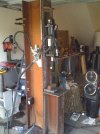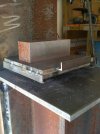- Joined
- Jan 10, 2005
- Messages
- 105
Hello,
About to finish my hydraulic press so that I can venture into Damascus making but I am having some trouble finding good references showing how to make various patterns. I purchased a book called "The pattern welded blade" but it has yet to arrive and have looked at some DVDs, but wasn't sure what is the best reference. Can anyone point me to some good references showing how to make different patterns of damascus? Any help would be greatly apprieciated.
About to finish my hydraulic press so that I can venture into Damascus making but I am having some trouble finding good references showing how to make various patterns. I purchased a book called "The pattern welded blade" but it has yet to arrive and have looked at some DVDs, but wasn't sure what is the best reference. Can anyone point me to some good references showing how to make different patterns of damascus? Any help would be greatly apprieciated.


